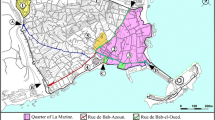Abstract
The directly observed spatial morphology and current landscape pattern data are important premises for optimizing and updating historical districts. Taking the Central Street of Harbin for example, the paper analyzes the block spatial structure, landscape pattern, architectural color, and spatial visual perception through ArcGIS software technology, based on architectural vector data and road vector data. The result shows that the D/H of the main street is between 1 and 2 with a low sense of space pressure and a phased sense of spatial enclosure. The spatial structure of “one main road with multiple frontage roads” has more spatial intersection nodes, forming a progressive relationship between the primary road and secondary ones. Architectures of different European and quasi-European styles created the continuity in space and spatial enclosure among all preserved buildings. The enlarged visual angle of the intersection of the main and the frontage road forms a corner space, with strong depth perception while the sight extends along the frontage road. The primary colors of the building façade in the district are beige and gray with red and green as the embellishment color. To protect the original cultural elements in the historical districts, the space renovation concept adopts the idea of “knowledge tour box,” laying a theoretical foundation for optimizing the space structure and the heritage protection of the historical districts in the winter cities.








Similar content being viewed by others
References
Feng CY, Zhang JQ, Lin JF (2019) The research on the identification of urban ecosystem protection base and assessment on biological assets through remote sensing and GIS technology. Adv Environ Protect 9(5):619–633
Fu BD (2018) The research on the application of GIS in making the protection plan for the historical district, a case study of Sufu Old Street originated from Ming and Qing Dynasty in Anhui. Rural Tech 33:113–114
Lai SP, Xu JG (2007) The application of GIS in the control detailed plan of the East Street Historic District in the Changting County. Anhui Agricult Technol 13:3933–3935
Li JB (2015a) The spatial analysis on a vibrant city streets, a case study of Harbin Central Avenue. Urban Construct Theory Res 5(14):4273–4274
Li JN (2015b) The GIS-based research on the “Three Lanes and Seven Alleys” Historical District in Fuzhou. Fuzhou University, Fuzhou, pp 22–40
Li TR (2015c) The research on the street landscape design for the pedestrian. Hebei Agricultural University, Baoding, pp 1–10
Li W (2019) An open investigation and research on sightseeing linguistic landscape, a case study of the Harbin Central Avenue and the scenery sites. J Harbin Coll 40(11):117–122
Liu C, Li YS, Xie JL et al (2019) The GIS-based biological sensitivity analysis on suburban area. J Geom 44(1):108–110
Mohamed EH (2020) Using of GIS technology for conservation of the ottoman bathroom and its urban surrounding in Qena—Egypt. Archaeologic Discov 8(1):26–46
Vileikis O, Carrillo EE, Allayarov SEA (2017) Documentation for preservation: methodology and a GIS database of three world heritage cities in Uzbekistan. ISPRS Annals of photogrammetric. Remote Sens Spatial Inform Sci 2:311–318
Wang YZ (2019) The application of GIS technology and digital mapping in engineer measurement. China Construct 25:148–149
Wu J, Ge BX (2016) The application of the analytic hierarchy process in commercial pedestrian landscape assessment. J Tianjin Chengjian Univ 22(2):98–103
Wu J, Meng QFX, Ma Y, Sun M, Sun N, Tan W (2018) Study on the relationship between multi-stage strike-slip mechanism and basin evolution in Fangzheng fault depression. Earth Sci Res J 22:335–339
Xu A (2020) Remote Monitoring system of geological exploration in lava area based on GPS. Earth Sci Res J 24:207–214
Yang YY (2020) The analysis on the application of GIS technology in topography and cadastral mapping. China Metal J 5:144–144
Yue YK, Wei W (2010) A GIS-based study on urban historical district, a case study of Yiyuan Historical District in Hankou. Chin Overseas Architec 11:115–117
Zhang SX, Lu Z (2013) The application of ArcGis in the space creation in the Taiping Street Historical District. Central China Architec 31(8):43–46
Zhao CY (2014) The protection and use of the external environment around the historical buildings of universities in Harbin. Northeast Forestry University, Harbin, p 78
Zheng XH, Shen J, Ma WY (2011) The construction and application of a GIS-based historical architecture value assessment system, a case study of “Nanjing Santiaoying Historical culture district protection plan”. Modern Urban Res 26(4):19–23
Zhou Y, Yan R (2015) The analysis of urban landscape and planning based on GIS technology. J Simul 3(3):6–9
Zhu D, Wan L, Gao W (2019) Fusion methods evaluation and classification suitability study of wetland satellite imagery. Earth Sci Res J 23:339–346
Author information
Authors and Affiliations
Corresponding author
Ethics declarations
Conflict of interest
The authors declare that they have no competing interests.
Additional information
Responsible Editor: Keda Cai
This article is part of the Topical Collection on Geodesy and Geodynamics of China
Rights and permissions
About this article
Cite this article
Hong, L., Pang, S., Geng, M. et al. The GIS study on the spatial structure and visual perception of historical districts in winter cities. Arab J Geosci 14, 1142 (2021). https://doi.org/10.1007/s12517-021-07481-w
Received:
Accepted:
Published:
DOI: https://doi.org/10.1007/s12517-021-07481-w




